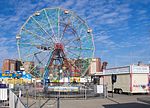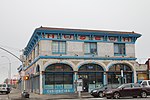The Riegelmann Boardwalk (also known as the Coney Island Boardwalk) is a 2.7-mile-long (4.3 km) boardwalk along the southern shore of the Coney Island peninsula in the New York City borough of Brooklyn, facing the Atlantic Ocean. Opened in 1923, the boardwalk runs between West 37th Street at the edge of the Sea Gate neighborhood to the west and Brighton 15th Street in Brighton Beach to the east. It is operated by the New York City Department of Parks and Recreation (NYC Parks).
The Riegelmann Boardwalk is primarily made of wooden planks arranged in a chevron pattern. It ranges from 50 to 80 feet (15 to 24 m) wide and is raised slightly above sea level. The boardwalk connects several amusement areas and attractions on Coney Island, including the New York Aquarium, Luna Park, Deno's Wonder Wheel Amusement Park, and Maimonides Park. It has become an icon of Coney Island, with numerous appearances in the visual arts, music, and film. After its completion, the boardwalk was considered the most important public works project in Brooklyn since the Brooklyn Bridge, with a comparable impact to the Catskill Watershed and Central Park.
By the mid-19th century, the Coney Island waterfront was divided among several private entities who erected barriers. Plans for a Coney Island boardwalk were first discussed in the late 1890s as a means of uniting the different sections of Coney Island, and as a revitalization project for these areas. The boardwalk, designed by Philip P. Farley, was named after Brooklyn borough president Edward J. Riegelmann, who led its construction. The Riegelmann Boardwalk's first portion opened in 1923, with further extensions in 1926 and 1941, as well as several modifications and repairs throughout the 20th century. After NYC Parks unsuccessfully attempted to repair the boardwalk with concrete in the early 21st century, the New York City Landmarks Preservation Commission designated the Riegelmann Boardwalk a city landmark in 2018.












